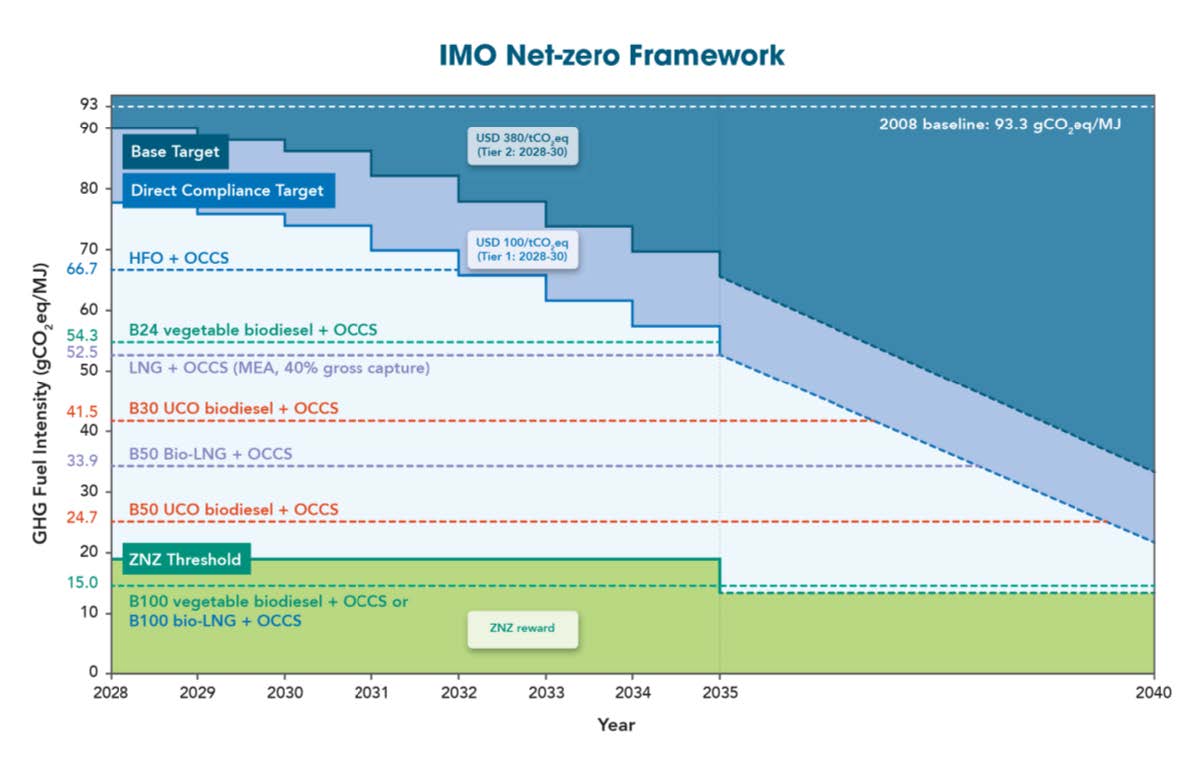A comprehensive life cycle assessment (LCA) conducted by the Global Centre for Maritime Decarbonisation (GCMD) quantifies OCCS’s potential to provide GHG emissions savings.
The study, named COLOSSUS (Carbon capture, offloading, onshore storage, utilisation and permanent storage), provides an in-depth analysis of GHG emissions and costs associated with OCCS across the entire carbon value chain, accounting for emissions from fuel production, transport and use, to CO2 capture onboard the vessel and its final disposition.
LCAs facilitate an equivalent comparison of different decarbonisation measures; this comparison can help shipowners make informed decisions on solutions adoption based on their net abatement impact across the entire carbon value chain. This holistic quantification of emissions ensures that OCCS adoption does not lead to inadvertent increases in emissions in adjacent sectors because of decisions made downstream.
While LCAs are available for onshore carbon capture technologies in themselves, assessments of the overall GHG emissions from deploying these solutions onboard vessels across the associated value chains are limited. A full assessment would require the inclusion of the well-to-tank (WtT) emissions of the fuel, onboard tank-to-wake (TtW) emissions, including those associated with OCCS operations, the subsequent emissions from transporting captured CO2, and those associated with permanent storage or its utilisation.
Professor Lynn Loo, CEO, GCMD said: “As we face an increasing array of decarbonisation solutions spanning different industries and value chains, coupled with the challenges of quantifying and elucidating carbon flows from source to sink including its re-use, there is a pressing need for a comparable means to understand their net abatement impact. We hope this LCA study for OCCS provides a foundation for the comprehensive understanding needed to shape robust regulatory frameworks surrounding OCCS, and supports decision makers in making informed, value chain-based decisions.”
What this study considers
The study used a WtW GHG emissions of 93.3 gCO2eq/MJ for Heavy Fuel Oil (HFO) as a baseline for comparison against other scenarios. This study explored five OCCS technologies, with six marine fuel options, and three post-capture scenarios. Among OCCS technologies, the study examined different post-capture scenarios with conventional monoethanolamine (MEA)-based OCCS, with it being the most mature of the OCCS technologies in the industry. Based on the practical limitations of storing large quantities of liquid CO2 onboard vessels, the study further assumed a 40% gross carbon capture for all scenarios explored, consistent with industry recommendations.
Key findings
Notably, the deployment of conventional MEA-based OCCS can result in a WtW GHG emissions savings of 29% for an HFO-fuelled ship.
Replacing HFO with biofuels presents a promising strategy for maximising GHG emissions savings. The WtW emissions savings for a vessel deploying MEA-based OCCS range from 69% to 121% when using bio-LNG and biodiesel from used cooking oil, respectively.
Among the post-capture scenarios evaluated, fixing the captured CO2 in concrete is most effective. This approach can increase GHG emissions savings from 29% to 60% across the carbon value chain by partially displacing the need for carbon-intensive cement in applications ashore.
Post-capture transport and permanent storage of CO2 add minimal emissions, approximately 1% to the WtW emissions of a vessel deploying MEA-based OCCS when the captured CO2 is transported 1,000 km.
Captured CO2 can also be used to produce e-methanol with renewable electricity, allowing the vessel that consumes this e-methanol to claim a 17% GHG emissions savings.
The cost of avoided carbon for OCCS with permanent storage is between USD 269-405/tCO2 for a 40% gross capture on an MR tanker, considering a full-scale, Nth-of-a-kind installation of an OCCS system with full heat recovery.
Viability of OCCS to help shipowners reduce GHG emissions
While the recently articulated GHG Fuel Intensity (GFI) framework does not explicitly specify how emissions reduction from OCCS is taken into consideration, the study offers a structured basis for assessing the solution’s potential in helping shipowners and operators manage their emissions portfolio.
By calculating the abatement from OCCS based on the amount of CO₂ it removes per unit of energy (in gCO₂eq/MJ) on a WtW approach, an “equivalent” GFI can be derived. Extending this concept, the study shows an HFO-fuelled ship adopting MEA-based OCCS at 40% gross capture can, on a WtW basis, maintain an equivalent GFI below the direct compliance target until 2032. Similarly, LNG-fuelled ships equipped with the same OCCS can maintain an equivalent GFI below the direct compliance target until 2035. Further, when fossil fuels are completely replaced by their bio-counterparts, OCCS can lower the GFI enough for the ship to be compliant with the more stringent 2040 targets.

GFI target compliance strategies for ships adopting OCCS and biofuels. OCCS technology is based on MEA capture and 40% gross capture rate, on a WtW basis. The values of GHG fuel intensity for biofuels are averaged based on different biomass sources and biofuel production processes. ZNZ (zero or near-zero) threshold is the GFI value below which ships are eligible for financial rewards.

GFI target compliance strategies for ships adopting OCCS and biofuels. OCCS technology is based on MEA capture and 40% gross capture rate, on a WtW basis. The values of GHG fuel intensity for biofuels are averaged based on different biomass sources and biofuel production processes. ZNZ (zero or near-zero) threshold is the GFI value below which ships are eligible for financial rewards.
source: Global Centre for Maritime Decarbonisation
The opinions expressed herein are the author's and not necessarily those of The Xinde Marine News.
Please Contact Us at:
media@xindemarine.com






